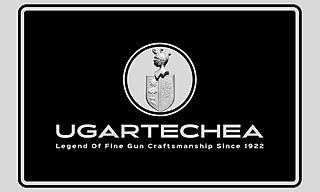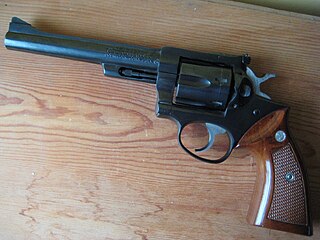
A shotgun is a long-barreled firearm designed to shoot a straight-walled cartridge known as a shotshell, which discharges numerous small spherical projectiles called shot, or a single solid projectile called a slug. Shotguns are most commonly used as smoothbore firearms, meaning that their gun barrels have no rifling on the inner wall, but rifled barrels for shooting sabot slugs are also available.
The Winchester Model 1897, also known as the Model 97, M97, Riot Gun, or Trench Gun, is a pump-action shotgun with an external hammer and tube magazine manufactured by the Winchester Repeating Arms Company. The Model 1897 was an evolution of the Winchester Model 1893 designed by John Browning. From 1897 until 1957, over one million of these shotguns were produced. The Model 1897 was offered in numerous barrel lengths and grades, chambered in 12 and 16 gauge, and as a solid frame or takedown. The 16-gauge guns had a standard barrel length of 28 in (71 cm), while 12-gauge guns were furnished with 30 in (76 cm) barrels. Special length barrels could be ordered in lengths as short as 20 in (51 cm) or as long as 36 in (91 cm). Since the time the Model 1897 was first manufactured, it has been used to great effect by American military personnel, law enforcement officers, and hunters.
Savage Arms is an American gunmaker based in Westfield, Massachusetts, with operations in Canada and China, PRC. Savage makes a variety of rimfire and centerfire rifles, as well as Stevens single-shot rifles and shotguns. The company is best known for the Model 99 lever-action rifle, no longer in production, and the .300 Savage. Savage was a subsidiary of Vista Outdoor until 2019 when it was spun off.

The Mossberg 500 (M500) is a series of pump action shotguns manufactured by O.F. Mossberg & Sons. The 500 series comprises widely varying models of hammerless repeaters, all of which share the same basic receiver and action, but differ in bore size, barrel length, choke options, magazine capacity, stock and forearm materials. Model numbers included in the 500 series are the 500, 505, 510, 535, and 590. The Revelation 310 and the New Haven 600 were also variations of the 500 series produced by Mossberg under different names. By 2021, 11,000,000 M500s had been produced, making it the most-produced shotgun of all time.

The .410 bore (10.4 mm) is one of the smallest caliber of shotgun shell commonly available. A .410 bore shotgun loaded with shot shells is well suited for small game hunting and pest control. The .410 started off in the United Kingdom as a garden gun along with the .360 and the No. 3 bore (9 mm) rimfire, No. 2 bore (7 mm) rimfire, and No. 1 bore (6 mm) rimfire. .410 shells have similar base dimensions to the .45 Colt cartridge, allowing many single-shot firearms, as well as derringers and revolvers chambered in that caliber, to fire .410 shot shells without any modifications.

A riot shotgun is a shotgun designed or modified for use as a primarily defensive weapon, by the use of a short barrel and sometimes a larger magazine capacity than shotguns marketed for hunting. The riot shotgun is used by military personnel for guard duty and was at one time used for riot control, and is commonly used as a door breaching and patrol weapon by law enforcement personnel, as well as a home defense weapon by civilians. Guns of this type are often labeled as breaching shotguns, tactical shotguns or special-purpose shotguns to denote the larger scope of their use; however, these are largely marketing terms.
The Winchester Model 1887 and Winchester Model 1901 are lever-action shotguns originally designed by famed American gun designer John Browning and produced by the Winchester Repeating Arms Company during the late 19th and early 20th centuries. The shotgun has become iconic for its use in the 1991 film Terminator 2: Judgment Day.

The gauge of a firearm is a unit of measurement used to express the inner diameter of the barrel.
The Ithaca 37, also known as the Ithaca Model 37, is a pump-action shotgun made in large numbers for the civilian, law enforcement and military markets. Based on a 1915 patent by firearms designer John Browning for a shotgun initially marketed as the Remington Model 17, it utilizes a novel combination ejection/loading port on the bottom of the gun which leaves the sides closed to the elements.

The AA-12, originally designed and known as the Atchisson Assault Shotgun, is an automatic combat shotgun developed in 1972 by Maxwell Atchisson. The most prominent feature is reduced recoil. The current 2005 version has been developed over 18 years since the patent was sold to Military Police Systems, Inc. The original design was the basis of several later weapons, including the USAS-12 combat shotgun. The shotgun fires in fully automatic mode only. However, the relatively low cyclic rate of fire of around 300 rounds per minute enables the shooter to fire individual rounds through the use of short trigger pulls. It is fed from either an 8-round box magazine, 20-round drum magazine, or a 32-round drum magazine. The charging handle is located at the top of the gun and does not reciprocate during firing.

The Auto & Burglar Gun was a US-made factory-built handgun that was commercially manufactured by configuring a standard double-barrel shotgun with a pistol grip, at first engraving and later stamping "Auto & Burglar Gun" on each side of the frame, and shortening the barrels to about 10" to 12.2" in length. A holster with a flap and a snap was available for purchase from Ithaca. It was outsourced to a leather company and was embossed with "Auto & Burglar" on it. They are also very rare and are infrequently seen for sale in any condition.

A combination gun is a firearm that usually comprises at least one rifled barrel and one smoothbore barrel, that is typically used with shot or some type of shotgun slug. Most have been break-action guns, although there have been other designs as well. Combination guns using one rifled and one smoothbore barrel are commonly found in an over-and-under configuration, while the side-by-side configuration is usually referred to as a cape gun. A combination gun with more than two barrels is called a drilling with three barrels, a vierling with four barrels, and a fünfling with five barrels. Combination guns generally use rimmed cartridges, as rimless cartridges are usually more difficult to extract from a break-action firearm.

The Colt Detective Special is a six-shot, carbon steel framed, 2-inch (5.1 cm) or 3-inch (7.6 cm) barreled, double-action revolver, and the first example of a class of firearms known as "snubnose revolvers". Made by Colt's Manufacturing Company, this model revolver, as the name "Detective Special" suggests, was intended to be a concealed weapon used by plainclothes police detectives.

Stevens Arms was an American firearms manufacturer founded by Joshua Stevens in 1864 in Chicopee, Massachusetts. The company introduced the .22 Long Rifle round and made a number of rifle, shotgun, and target pistol designs. By 1902, they were advertising themselves as "the largest producers of sporting arms in the world". They were purchased by New England Westinghouse on May 28, 1915, and again by Savage Arms on April 1, 1920. As a division of Savage, Stevens continued to produce firearms at their Chicopee Falls facility until 1960 when the plant was torn down and Stevens production was moved into other Savage facilities. Savage dropped the Stevens name in 1991, but revived it in 1999 and still uses it today for a number of its low cost rifles and shotguns.

Armas Ugartechea is a Basque Spanish manufacturer of guns and rifles located in Eibar, is a privately held Spanish firearms manufacturing company. Its firearms are used worldwide for a variety of sporting and hunting purposes. It produces several models of double-barreled shotgun. It is devoted to the craft manufacturing of fine hunting shotguns and is the heir of a long craftsman tradition that has cleverly incorporated new technologies in the production of its guns, and, at the same time, keeping its traditional know how. It was the first Spanish company to start making under and over barrel guns. I. Ugartechea is well known for the quality of its work both at home and abroad. Is one of the few gunmakers to produce its own barrels, flawless at best. A present, Armas Ugartechea sells its guns worldwide. Among its customers are heads of state and monarchs from several countries, as well as top hunters and crack shots. The Ugartechea Family is still in charge of the company which is a basic principle, as they are the ones who know better how to optimize the manufacture of these firearms, which combine with craftsman work the best technology.
In 1915 John Browning patented a pump-action shotgun with the following features: hammerless, under-loading, tubular-magazine, bottom-ejecting, and take-down. This design would eventually become the Remington Model 17. Manufacturing rights were sold to Remington Arms shortly after, but due to the production efforts of World War I, Remington was unable to begin manufacturing until 1921. Before production began John Pedersen made alterations to the design, with more changes made later by G. H. Garrison. The Model 17 was a trim, 20-gauge shotgun that served as the design basis for three highly successful shotguns: the Remington Model 31, the Ithaca 37 and the Browning BPS. Additionally, features of the Model 17 were also incorporated in the later Mossberg 500 and Remington 870.

The Ruger Security-Six and its variants, the Service-Six and Speed-Six are a product line of double-action revolvers introduced in 1972 and manufactured until 1988 by Sturm, Ruger & Co. These revolvers were marketed to law enforcement duty issue, military, and civilian self-defense markets.

The Savage Model 24 is an American made over-and-under combination gun manufactured by Savage Arms. The basic .22LR over .410 gauge model weighs 7 pounds, has 24-inch barrels and an overall length of 41-inches. It may also be disassembled for ease of storage.
The Stevens Model 520 was a pump-action shotgun developed by John Browning and originally manufactured by the J Stevens Arms & Tool Company between 1909 and 1916. Stevens was sold to New England Westinghouse on 28 May 1915 and production of civilian firearms was greatly reduced. The company was renamed the "J Stevens Arms Company" on 1 July 1916 and New England Westinghouse used their manufacturing facility in Chicopee Falls, MA to produce Mosin-Nagant rifles under contract for the Russian Czar during World War I. After the war, Stevens was sold to Savage Arms on 1 April 1920 and full production of civilian firearms resumed. Under Savage ownership, Model 520 production continued until 1939 when it was replaced by the Model 520A which ended production in 1948. Stevens also further modified the design when they introduced the streamlined Model 620 in 1927. The Model 620 was internally similar to the Model 520 and was produced until 1939 when it was replaced by the Model 620A which ended production in 1955. This shotgun is a hammerless, pump action, take-down design with a tubular magazine which holds 5 shells. All models can also be slam fired: the shotgun has no trigger disconnector and shells can be fired one after the other simply by working the slide if the trigger is held down.
The Chiappa Double Badger is an Italian made over and under combination gun manufactured by Chiappa Firearms. It comes in four versions: .22 LR over .410 bore, .22 WMR over .410 bore, .22 LR over 20 gauge, and .243 Winchester over .410 bore. It's marketed as "a great choice for hunting, survival, or fun recreational shooting".












